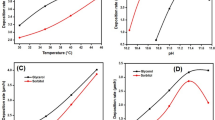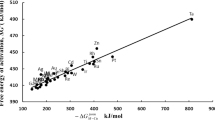Abstract
The work justifies the selection of a sulfosalicylate copper–nickel electrolyte and its composition for obtaining nanostructures comprising alternate magnetic and nonmagnetic layers by a single-bath method. According to calculations of an equilibrium composition of the electrolyte and electrodiffusion fluxes of discharging species, in a neutral region of pH copper exists in the form of multicharged anions CuSSA3–, and the migration effects must reduce the rate of the mass transfer of copper-containing species with increasing current of the parallel reaction of discharge of nickel ions. Dependences of the partial current density of copper deposition on the electrode potential are studied at various values of pH of the copper and copper–nickel electrolytes. Experimental results are analyzed on the basis of modeling concepts. It is shown that the drop of the partial current density of copper deposition below its limiting value at potentials of deposition of a magnetic layer is connected with the emergence of migration effects.
Similar content being viewed by others
References
Ovchinnikova, S.N., Poddubnyi, N.P., Maslii, A.I., Boldyrev, V.V., and Schwarzacher, W., Elektrokhimiya, 2002, vol. 38, p. 1339.
Lur'e, Yu.Yu., Spravochnik po analiticheskoi khimii (A Handbook of Analytical Chemistry), Moscow: Khimiya, 1979, p. 321.
Bjerrum, J.L., Stability Constants of Metal Ion Complexes, part 1: Organic Ligands, The Chemical Society, Burlington House, vol. 1, 1957.
Van Zee, J. and Newman, J., J. Electrochem. Soc., 1977, vol. 124, p. 706.
Masliy, A.I., Ovchinnikova, S.N., Schwarzacher, W., Weiss, A.A., Laskarzhevskiy, P.A., and Boldyrev, V.V., Proc. Symp. Fundamentals of Electrochem. Deposition and Dissolution, Electrochemical Society Proc., 1999, vol. 99-33, p. 375.
Tarasova, V.A. and Kletenik, Yu.B., Zavod. Lab., 1977, no. 8, p. 7.
Aleksandrova, T.P., Ovchinnikova, S.N., Weiss, A.A., and Bek, R.Yu., Zh. Anal. Khim., 1999, vol. 54, p. 719.
Bonnet, M. and Paris, R.A., Bull. Soc. Chim. Fr., 1966, p. 747.
Kharkats, Yu.I., Itogi Nauki Tekh., Ser.: Elektrokhimiya, 1991, vol. 38, p. 1.
Ibl, N. and Venczel, J., Metalloberflache, 1970, vol. 24, p. 365.
Tindall, G.W. and Bruckenstein, S., Anal. Chem., 1968, vol. 40, p. 1402.
Kazeminezhad, I. and Schwarzacher, W., J. Magn. Magn. Mater., 2001, vol. 230, p. 1650.
Author information
Authors and Affiliations
Rights and permissions
About this article
Cite this article
Ovchinnikova, S.N., Poddubnyi, N.P. & Maslii, A.I. Mutual Influence of Electrode Processes during Electrodeposition of Layered Structures by a Single-Bath Method: Effect of Nickel Deposition and Hydrogen Evolution on the Mass Transfer of Copper in a Sulfosalicylate Electrolyte. Russian Journal of Electrochemistry 39, 679–684 (2003). https://doi.org/10.1023/A:1024117714424
Issue Date:
DOI: https://doi.org/10.1023/A:1024117714424




